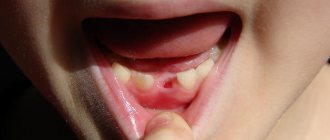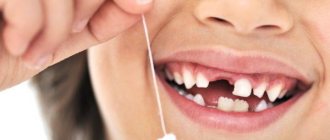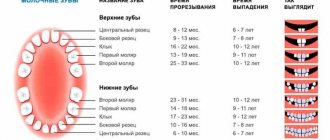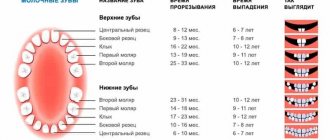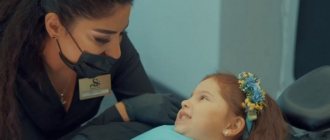In children from the age of 5, temporary milk teeth begin to fall out and are gradually replaced by permanent ones, which will serve for the rest of their lives. Many parents are interested in the question: how many teeth change in childhood? All baby teeth fall in, and permanent teeth grow in their place. They change in the same order as during teething. But parents should know that at the age of 6-7, the baby begins to grow his first permanent molars (sixth teeth) - they are the ones that remain for life. Children's fifth molars are the last to fall out and are replaced with permanent molars. Teeth are completely replaced by about 12-14 years, but it all depends on the individual characteristics of the body and various other factors.
Often, during tooth replacement, some non-standard situations and features can be observed, because of which parents begin to worry. Let's take a brief look at the most common questions:
What reactions of a child’s body are possible during the period of loss of baby teeth and growth of permanent teeth?
Replacing teeth is almost painless. The loss of baby teeth occurs on their own after their root is completely absorbed or removed at home, and if the permanent tooth is already growing, but the permanent one has not yet fallen out, the help of a pediatric dentist is required. When permanent teeth erupt, pain usually does not occur. Very rarely, there may be a slight increase in body temperature, itching of the gums or discomfort in the abdomen. In this case, the child does not need treatment, but it is recommended to visit a dentist.
Who to turn to for help
If your child has lost a baby tooth and a new one is not growing, he may have a metabolic disorder. It is best to contact your pediatrician to prescribe the appropriate examinations and tests. Further, long-term hospital therapy will be required if we are talking about a complex case. If necessary, the doctor will write out a referral to an orthodontist. This specialist will install dental plates and also explain why the baby tooth has fallen out and the permanent tooth has not grown in for a certain time.
Why can a lot of time pass between the loss of baby teeth and the eruption of permanent teeth?
Most often, the front teeth grow quickly. And canines and baby molars (premolars) can be delayed. After a temporary tooth falls out, it may even take 4-6 months until a permanent tooth erupts in that place. Just expect it and take good oral care. But if this period begins to exceed six months, so as not to worry, it is better to visit a doctor. After examining the child, he will be able to decide whether the permanent tooth needs to be stimulated to grow.
What can be done to improve the situation
If you find that your child has lost a baby tooth and a new one is not growing, you can influence the process of tooth development. Firstly, care must be taken to ensure that an infectious disease does not develop. Secondly, it is necessary to develop the child’s diet in such a way that he has enough vitamins and calcium. If there is an injury to the oral cavity, you must contact a medical facility. It is necessary to promptly restore the functionality of the gums even before the development of molars. If we are talking about a complex case, then radical treatment methods will be required.
Only a dentist can determine at what stage of development a particular molar is. Remember that the front baby teeth of the lower row must fall out first.
If the cause of the pathology is an infectious disease, it is necessary to restore the child’s immune system. It is also advisable for the baby not to worry and avoid stress.
Which teeth should an eight-year-old child have?
Every child who has reached the age of eight should normally have the following permanent teeth - 4 lower and 4 upper incisors, sixth molars. Sometimes there may be individual deviations in teething within plus or minus six months.
Why is it necessary to treat caries in childhood if you then have to remove baby teeth with filled roots?
If an empty space forms in the dentition, this contributes to the fact that the remaining milk teeth shift, and along with them, the rudiments of permanent teeth also shift and they begin to grow incorrectly under them - in one place the formation of cracks begins, and in another - the teeth fit alone another. A filled, treated baby tooth will save space for a permanent tooth. Untreated teeth infect the rudiments of permanent teeth with infection, which causes their deformation and even complete absence.
Other causes of deviations
Worried about why a baby tooth has fallen out and a new one is not growing, many parents think about physical pathologies. They do not realize that there are some other reasons that contribute to the disruption of the development of permanent dentition. Negative factors include:
- Poor environmental conditions.
- Eating foods that are harmful to the body.
- Frequent stressful situations.
- Eating cereals and purees too often.
Why can a 7-14 year old child sometimes experience pain when all his teeth are intact?
Yes, this can happen, but in this case the pain occurs not in the tooth itself, but in the jaw, which is growing rapidly at this age. Since permanent teeth are almost twice as large as baby teeth, they need much more space. Therefore, large new teeth can sometimes overlap each other or grow at an angle, getting out of the dentition. As the jaw grows, they align and settle into place. But a qualified specialist can competently assess this situation, as well as the risk of anomalies and developmental defects. That is why in this case you will need to consult an orthodontist.
Reasons for retention
Most often, the reason for the development of retention is associated with the incorrect location of neighboring teeth, which become an obstacle to the eruption of retention teeth. In other cases, the problem may be due to too dense bone or gum tissue.
Other factors influencing the development of pathology include the following phenomena:
- supernumerary (abnormally large number of teeth),
- diseases of internal organs, which leads to disruption of the full development of the entire skeletal system,
- loss of baby teeth at too early an age,
- genetic predisposition.
At what age should a bite be corrected?
You can start correcting your bite at 4-5 years of age. In this case, the growth of permanent teeth will be even, in the place intended by nature. Therefore, there is no need to carry out subsequent long-term bite correction. In any case, if there is a malocclusion, the problem can be eliminated efficiently and as quickly as possible by contacting a qualified orthodontist as early as possible.
| Teeth | Dairy (temporary) | Permanent | ||
| Jaw | Lower | Upper | Lower | Upper |
| Central incisors | 6-12 months | 8-12 months | 6-7 years | 6-8 years |
| Lateral incisors | 10-16 months | 9-13 months | 7-8 years | 7-8 years |
| Fangs | 17-23 months | 16-22 months | 9-10 years | 11-12 years old |
| First Premolars | — | — | 10-12 years | 10-11 years |
| Second Premolars | — | — | 11-12 years old | 10-12 years |
| First Molars | 14-18 months | 13-19 months | 6-7 years | 6-7 years |
| Second Molars | 23-33 months | 25-33 months | 11-12 years old | 11-13 years old |
Timing of eruption of molars
Before you figure out why baby teeth fall out and new ones don’t grow, you need to find out the timing and norms for the growth of molars, established by dentists. This will allow you not to panic ahead of time and consult a doctor in time if necessary.
The rudiments of baby teeth begin to form in the first trimester of pregnancy (at 8 weeks), and at 20 weeks the rudiments of molar teeth are formed. They are located very deep in the baby's jaw. It should be understood that not all teeth that erupt in a little person will fall out in the future. Some of them become permanent immediately.
The baby's first tooth appears at approximately 6 months. By the age of three, all his teeth have grown. When do the molars erupt?
By about 7 years of age, the baby grows molars, which in dental practice are called sixth teeth. At the age of 11 to 13 years, molars also appear, but this time the 7th ones. These teeth do not have milk analogues; after eruption, they immediately become permanent. All other molars gradually replace baby teeth. At the age of 6 to 8 years, the child’s central incisors sprout, and from 7 to 9 years, the lateral incisors erupt. From 10 to 12 years of age, the child begins to grow premolars, which are also called fifth and fourth teeth, according to the dental formula. Molar canines erupt between the ages of 9 and 13 years. Adults develop wisdom teeth, but not always. Considering that the process of changing teeth takes place according to a certain schedule, parents are concerned about why their child is experiencing some kind of delay. Usually they are very worried about why the baby teeth have fallen out, but the permanent teeth are not growing.
Why do children lose teeth?
The formation of baby teeth in the jaw begins long before the baby is born. And the eruption of the first tooth becomes a real event. This usually happens at six months: parents notice bumps on the lower gum, the baby becomes capricious and restless. And after some time, the mouth is decorated with white “caps” of the first central incisors.
A little later, after two to four months, they are paired with the central incisors on the upper jaw. Then the lateral incisors, canines and molars appear in the mouth. The latter grow up by about two and a half to three years, and by this age most children acquire a complete milk bite. 20 baby teeth will serve the baby for at least another two to three years.
As the baby grows, his jaw also changes. It becomes larger, and if up to three years the teeth were arranged in dense, neat rows, then later gaps will begin to appear between them. Parents should not worry - this is a natural and necessary process. Interdental spaces, called diastemas, are needed so that later molars, larger than baby teeth, can take their place.
At the age of six or seven years, the changes become even more noticeable. The baby's first tooth may fall out. Usually, the one that appeared first, that is, the central incisor of the lower jaw, falls out first. This event indicates that the milk bite will begin to change into a permanent one. The baby’s body will need time to completely renew its dentition. This takes on average four to five years, and there is no need to rush things.
pixabay.com/
Parents are often worried that their children’s teeth are already actively changing, but their baby still walks around with a full, milky smile. These experiences are usually in vain, since nature has not programmed the only correct time for a person to change their bite. The indicated age for the loss of the first tooth is conditional. For some children this happens earlier - for example, at five years old. For others - after seven years, when the baby goes to school. It has been noticed that girls acquire molars earlier than boys. At the same time, the age at which baby teeth fall out is not as important as the correct order.
Reasons for delay
- There is not enough calcium in the body. The cause of the shortage was not necessarily the presence of pathology. Perhaps the baby was born prematurely, not having time to receive all the necessary microelements, or the tooth did not advance to the required level, or the mother did not eat well during pregnancy and did not consume foods containing calcium. In case of congenital calcium deficiency, the baby will have pale skin, brittle nails, and slow hair growth. In most cases, it is enough to switch the child to a balanced diet. It is very important that it not only includes foods high in calcium, but also excludes those that interfere with its absorption.
- Past infectious diseases. Perhaps, due to a serious illness, your baby has expended all the strength necessary to build a molar.
- Inflammatory processes in baby teeth, caries. In advanced conditions, the molar tooth germ is damaged. This leads to a delay in the growth of the permanent tooth, and it can also come out incorrectly, with an inclination. And this can lead to the formation of an incorrect bite.
- Impact of mechanical injuries. Perhaps the baby had a jaw injury, which caused the rudiments to shift. Now surgical intervention is needed to correct the situation.
- Adentia or retention.
Edentia
Sometimes the reason why a tooth does not grow is adentia - a disease that can be either congenital or acquired. In the case of congenital pathology, the culprit may be a hereditary factor, as well as smoking or drinking alcohol by the mother during pregnancy. Such a phenomenon as acquired adentia is typical in cases when a molar tooth is removed or when, due to infectious processes in a milk tooth, pathogenic microflora penetrates the molar rudiment and thereby destroys it.
When should you start worrying about delayed growth of molars:
- If in the near future after a baby tooth falls out, your little one doesn’t even have a hint of a permanent tooth, it’s too early to worry. Sometimes it takes a whole year for a molar to appear.
- Of course, there are tables that indicate the approximate timing of the appearance of permanent teeth. However, due to the fact that all children are individual and their physiological characteristics may differ, an error of even one and a half years is acceptable.
- If you are still worried, it is better to see a specialist. He can easily determine whether the baby has edentia. To do this, he will need an x-ray of the child's jaw. In addition, the baby can have a digital photograph taken, which will be less dangerous in terms of radiation exposure and more informative.
What to do if the diagnosis is confirmed? You must understand that this is not a verdict yet. The child will be able to receive special plates with artificial teeth, which will also be responsible for the formation of the correct bite in the baby. It is better not to delay the installation of such a device. You must understand that the baby may begin to have complexes, his bite will form incorrectly, and he will not be able to fully eat food.
Retention
This diagnosis is made when there is a serious delay in the eruption of a permanent tooth. If we are talking about complete retention, then in the picture you can see the presence of a tooth germ. However, for some reason it does not erupt from the gums. As a rule, this phenomenon is caused by the removal of a baby tooth for medical reasons ahead of schedule or by too deep localization of the molar rudiment.
Partial retention may also be diagnosed. In this case, the upper part of the tooth pecks, and the lower part does not come out for a long time.
To be honest, when my son’s teeth were falling out, I didn’t worry at all and didn’t look for information about the age when which molar should erupt. Once, my son had a baby tooth removed ahead of schedule (the tooth could not be treated). The doctor immediately warned that a molar would not appear there any time soon. That's why I wasn't worried. And all the other teeth were quickly replaced by molars, and there was no need to consult a doctor for advice.
Do baby teeth need to be pulled out?
There may be several reasons for removing baby teeth. Among them is the one mentioned above, when the permanent incisor or canine needs to be given the opportunity to erupt correctly and take its place in the gum. Another reason is the long absence of a molar tooth in place of the fallen milk tooth, which is prevented from appearing on the surface by tightly seated “neighbors.”
These reasons require the supervision of a specialist - an orthodontist, since they usually talk about insufficient jaw width. There was enough space in the mouth for small baby teeth, but there was too little space for larger permanent teeth. You can decide on removal on your own only if the incisor or fang is actively loose, which causes discomfort for the child and bleeding gums. And the only way to get rid of the problem is to pull out a tooth that is no longer needed and does not perform its functions.
If a change in bite occurs with disturbances, you need to consult a doctor. In childhood, the problem is solved by orthodontic treatment: wearing mouth guards or orthodontic devices - special plates. These products help gradually enlarge the jaw to allow the molars to grow properly. Orthodontic treatment is long-term, but painless and effective. The only thing it requires is discipline from the parents and the child himself.
pixabay.com/
Recommendations
- Pay special attention to your baby's nutrition. It is very important that his diet contains a sufficient amount of digestible calcium.
- Teach your child to maintain oral hygiene from an early age.
- An orthodontic type pacifier can be used.
- In order for the baby to form a correct bite, it is necessary not to allow him to suck his finger or chew a pencil. In addition, by such actions the child can introduce an infection into the oral cavity.
Now you know what to do if your baby teeth fall out and your molars don’t grow. After reading the article, you realized that the delay in timing can be explained by the individual characteristics of your baby’s body, and not necessarily by a pathological process. Do not forget about the factors that can cause acquired or congenital adentia and try to avoid them. If your baby’s health makes you think about going to the doctor, don’t delay it so as not to cause harm through inaction. Be healthy!
How to avoid problems
To avoid problems associated with delayed growth of molars,
Expectant mothers must adhere to some rules:
- Avoid bad habits, since smoking and drinking alcohol can negatively affect the development of tooth buds.
- Carefully monitor your oral hygiene and visit your dentist promptly.
- Take care of your health, do not contact sick people during pregnancy.
- Try to strengthen your immune system in every possible way.
- Avoid eating unhealthy foods.
- Do not self-medicate.
- Do not take antibacterial drugs under any circumstances without a doctor's prescription.
After the baby is born, remember these recommendations:
- Oral hygiene should be performed from the moment the first baby tooth appears.
- If caries is detected, do not forget about timely treatment. Baby teeth are highly susceptible to carious lesions.
- Protect your baby from injury.
- Remember that the child must eat properly and receive all the vitamins and minerals necessary for growth from food.
- Limit your intake of sweets.
- Make sure that sucking a pacifier or thumb does not become a bad habit. This may affect the development of the bite.
- After eating, the baby's mouth should be rinsed.
- Choose a suitable toothbrush and toothpaste for your child.
- Be sure to include solid foods in your diet, this will help ensure proper load on the jaw.
If you notice that a child’s molar does not appear for a long time, this is not a cause for concern. It would be a good idea to visit a pediatric dentist. Don't forget that all babies are individual, so the timing of the eruption of molars is different for everyone.
What to do if a tooth does not grow after a baby tooth falls out?
Ideally, teeth change as follows. The molar located in the gum begins to move upward. This serves as a signal to the dairy that it is time to make room. Its roots begin to dissolve, and it itself becomes mobile. The baby may feel that the tooth has become loose, but it will not fall out quickly. It takes time for the roots to be reabsorbed; this takes several months. As the molar or molar grows, the roots of the predecessor become smaller and smaller. At some point, it falls out, and in the hole that remains in its place, the cap of the original “replacement” is already visible.
But it also happens that a molar tooth does not replace a lost baby tooth. And this is a reason to consult an orthodontist.
“Such problems can arise if there is not enough space in the child’s bite for the eruption of permanent teeth,” comments pediatric dentist Victoria Arutyunova. - Molars are larger in size than baby teeth. And if the freed up space is not enough for a permanent tooth to erupt, it may remain in the gum.”
The orthodontist will give you a referral for a panoramic photograph of the jaw. This is a completely painless procedure that will allow you to see the location of all molars in the gums. Based on the image taken, the doctor will offer options for solving the problem. Modern orthodontic techniques help eliminate malocclusion in children of all ages.
pixabay.com/


